Paw Print = Anchorage ~ Teacher Conference last day, Dog Handler Class, I.C.E. training and COMMS training
Exploration Feeling ~ Day Six = Motivated
As the three of us started to head down the stairs toward our next adventure, I realized that our time is growing shorter together. This makes me realize how much I have already learned from these two wonderful educators. Then I thought, “I still have 3 more days with them. I am going to absorb all I can from them both. So all is good in the world.”
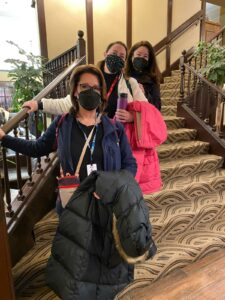 I need to give a big “shout-out” to the nurses that are running the Capstone Clinic. These wonderful nurses are on site of our hotel from 8:00 am to 8:00 pm everyday. They deal with people all day long in the cold weather without any complaints. It is because of their dedication to our safety that we are able to stay healthy. I wish I had time to interview one of them, however, I can only provide a loud – THANK YOU! 😀
I need to give a big “shout-out” to the nurses that are running the Capstone Clinic. These wonderful nurses are on site of our hotel from 8:00 am to 8:00 pm everyday. They deal with people all day long in the cold weather without any complaints. It is because of their dedication to our safety that we are able to stay healthy. I wish I had time to interview one of them, however, I can only provide a loud – THANK YOU! 😀

I know that I should feel sad because it is our last day at Winter Educator conference, however, I can only smile because of all the knowledge that I absorbed this entire week. Our guest speakers provided us all with a deeper understanding of the roles outside of the mushers. Rob Urbach, CEO of the Iditarod, shared the passion mushers have for their dogs. Mark Nordman, Race Director/Race Marshall reminded me of the power of believing in what you do. The volunteers, trailbreakers, trail sweepers and judges all demonstrate this with the time and efforts needed to run the Iditarod. I feel like my students could learn from the endeavors of the Junior trailblazers. We need to incorporate more stewardship at the elementary level. The Iditarod Air Force speaker included authentic stories on the trail beginning with the amount of hours they service flying the dogs to details of a pilots motivation. Reece Roberts from COMMunications shared a behind the scenes look at the transmission of information along the trail. Jeff Schultz continues to amaze me with his stories and visual of these stories. I feel like I have a better picture of the village it takes to run the Iditarod. Many of these villagers are VOLUNTEERS. So, another big shout out to all of the volunteers that help run the Iditarod. THANK YOU! 🙂
 Mark Nordman Race Director/Race Marshall |
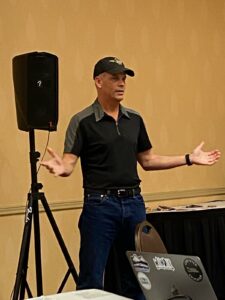 Iditarod Air Force sharing details about “flying the dogs” and a pilots motivation. |
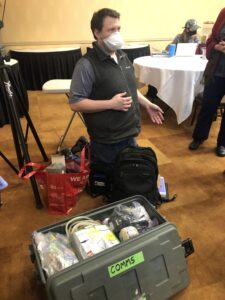 COMMs Coordinator Reece Roberts shares Cripple’s technology box. |
 Celebrating Jeff Schultz’ Chasing Dogs book about his adventurous backstage tour of the Iditarod Dog Sled Race. |
The dog handler class was another exciting event of my day. I learned how to handle a dog sled team, as well as what I should and should not do if they get tangled. I am officially certified for 5 years. I look forward to testing my certification out tomorrow morning at the ceremonial start in Anchorage, and again on Sunday for the restart in Willow.
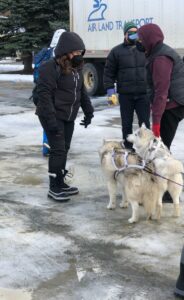 I introduced myself to my dogs before handling them. I think that is important. |
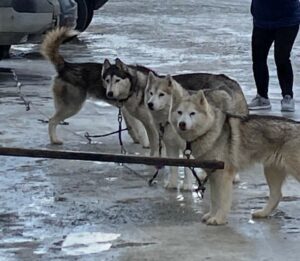 The dogs are patiently waiting for directions. |
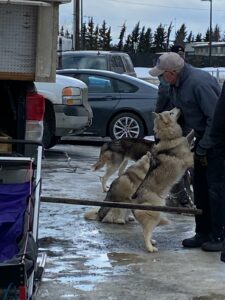 Now they are not patiently waiting for directions. They love their hugs. |
This afternoon I began checkpoint #1 toward my Iditarod Certified Educator (I.C.E.) Cohort. We met Iditarod Coordinator and Handler, Kerry Quake along with her dog Cookie. A whole new respect was gained for Debski the Great. She is the official Iditachef, who was clearly nominated by the volunteers, mushers and locals along the trail. I enjoyed her interview with Jen and Annie. Debski is clearly a lovely lady who enjoys countless hours of volunteer time she gives to the race. Thank you to Debski! I would say she is a terrific example of the many volunteers out there. THANK YOU Debski! 🙂
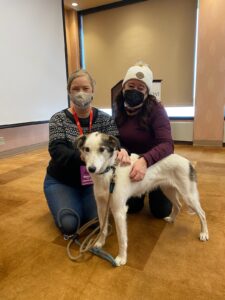 Kerry Quade, Cookie and Me |
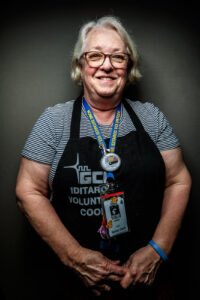 Debra Smykalski, FACES OF IDITAROD ~ thanks to Jeff Schultz |
So as I revisit my posting tonight, I have to ask myself, how can we accomplish a large goal without the help of others? How come all of these volunteers involved with the Iditarod are so invested? I realized that it is all because they have one thing in common – being intrinsically motivated. Self-motivation is a valuable life skill that we need to introduce to our students. Just like all the volunteers or all the mushers attempting challenges, intrinsic motivation is essential. How can we teach our students to be self-motivated? How can they learn from the volunteers involved with the Iditarod? Here are some ideas:
1.Research at least two volunteers that help at the Iditarod. It could also be from the Junior Iditarod. You could do this as a whole class or assign to students individually. Do a picture walk of the research gathered. Compare accomplishments of Iditarod volunteers to self. Promote self-reflection.
2. Set goals with your students. Have a conference with them to discuss where they are at and where they want to go. Some students may need steps or guidance. Use “Faces of the Iditarod” to help guide your lesson. Students can read stories and hear voices of selfless people involved in the Iditarod. https://iditarod.com/faces-of-the-iditarod/
3. Reframe student thinking to be a more “can do” attitude not “can’t do” attitude. Using the 5th trait under the article “8 Traits of the Iditarod” (ATTITUDE), ask students to compare/contrast examples of Susan Butcher or Granite’s story to oneself. https://iditarod.com/edu/category/8-traits-of-iditarod/
l


